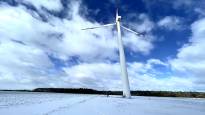WARSAW / NASIELSK An hour’s drive from Warsaw is the Nasielski wind farm. A park of five wind turbines is a rarity in Poland. The construction of onshore wind power has been frozen since 2016.
– During the last seven years, the construction of onshore wind turbines has been almost impossible. Legislation limits the potential of renewable energy, director of climate policy think tank Instrat Michał Hetmanski says to .
The restrictions are based on a law enacted by Poland’s national conservative government in 2016, according to which the distance between onshore wind farms and the nearest settlement must be ten times the height of the plant.
In practice, this means a requirement for several kilometers of uninhabited area around the wind turbines.
In densely populated Poland, this has meant that it has been difficult to find sites for wind turbines and that the construction of onshore wind power has practically stopped.
The EU recovery fund accelerates investments
Now the situation is about to change. Obstacles to the construction of wind power are being dismantled. The background is the EU’s green transition goals, which require member states to take action to increase renewable energy sources.
In February, the lower house of the Polish parliament passed a law which enables the construction of wind power (you switch to another service) closer to the settlement.
According to the new law, the distance must be 700 meters instead of the current two kilometers. This multiplies the surface area suitable for the construction of wind power.
The additional construction of wind power is part of approximately 35 billion euros recovery plan (you move to another service)which the EU and Poland have accepted together.
According to climate expert Hetmański, the EU’s corona recovery fund has had a decisive effect on the change of the Polish government’s hard line.
– No one in Brussels has forced Poland to invest in renewable energy. The government itself has approved the agreement, which requires new investments, Hetmański emphasizes.
Many swear by coal power
However, the position of fossil fuels is strong in Poland, which relies on coal power.
Almost 80 percent of the country’s electricity is produced using coal and other fossil fuels.
The energy crisis has led to demands for increased domestic coal production.
– In my opinion, Poland’s energy security should rely on its own resources. If we have our own coal and lignite deposits, they should also be utilized, Poland’s Deputy Minister of Agriculture Janusz Kowalski says in an interview with .
The Solidarna Polska party represented by Kowalski is part of Poland’s national conservative government, which has led the country since 2015. The party is critical of the additional construction of onshore wind power in Poland.
– Poland cannot make the same mistake as Germany, which invests billions in wind and solar power while destabilizing its electricity system, says Kowalski.
According to Kowalski, onshore wind turbines are perceived as disturbing and ruining the landscape. The Solidarna Polska party has demanded a minimum distance of one kilometer between wind turbines and the nearest settlement.
Poland’s center-left opposition and wind power developers, on the other hand, demand that the minimum distance be shortened from 700 meters to 500 meters, according to the government’s original proposal.
According to the Polish Wind Power Association, the law approved by the government is a bad compromise (you switch to another service)which may limit the construction of wind power in the long term.
Poland is a key player in the green transition
Poland’s combined carbon dioxide emissions are the second largest in the EU after Germany. The success of Poland’s green transition is thus also of great importance for the achievement of the EU’s common climate goals.
Poland aims to increase the share of renewable energy from the current 12% to 23% by 2030. At the same time, Poland utilizes its coal resources and invests in transitional technologies, such as natural gas.
In the negotiations with the EU, Poland has emphasized that it needs enough time to go through the green transition.
– Poland has a central position in terms of the EU’s climate goals. Without Poland, achieving the climate goals may become more difficult, says Michał Hetmański.
According to researches majority of Poles (you switch to another service) supports investments in renewable energy. The green transition is also seen as a way to weaken Russia’s influence.
– Russia’s attack on Ukraine has changed everything. People began to understand that a green and just transition is one of our most powerful tools [presidentti Vladimir] Putin and against Russia, a climate activist Wiktoria Jędroszkowiak says.
